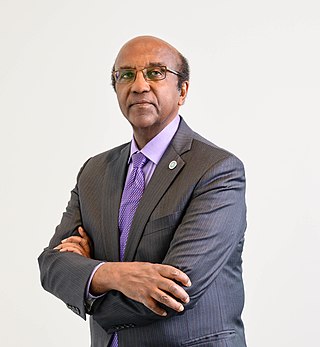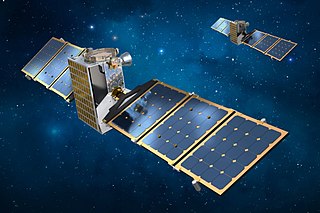Related Research Articles

The University of Colorado Boulder is a public research university in Boulder,Colorado,United States. Founded in 1876,five months before Colorado became a state,it is the flagship university of the University of Colorado system. CU Boulder is a member of the Association of American Universities and is classified among R1:Doctoral Universities –Very high research activity.

The Summer Science Program (SSP) is an academic summer program where high school students experience college-level education and do research in celestial mechanics by studying the orbits of asteroids,biochemistry by studying the kinetic properties of enzymes,or genomics by studying antibiotic resistance. The program was established in 1959 at The Thacher School in Ojai,California. It now takes place on three astrophysics campuses,New Mexico Tech in Socorro,New Mexico,the University of North Carolina at Chapel Hill in Chapel Hill,North Carolina,and University of Colorado,Boulder in Boulder,Colorado,and two biochemistry campuses,Purdue University in West Lafayette,Indiana and Indiana University Bloomington in Bloomington,Indiana.
The Colorado Center for Astrodynamics Research (CCAR) is a renowned aerospace research center specializing in orbital mechanics and spacecraft navigation,located at the University of Colorado at Boulder. CCAR was established at the University of Colorado at Boulder in the College of Engineering and Applied science during the fall of 1985 as a part of the University of Colorado's commitment to develop a program of excellence in space science and is hosted by the Department of Aerospace Engineering Sciences. CCAR is a multidisciplinary group involving faculty,staff and students from the Department of Aerospace Engineering Sciences. Its research program emphasizes astrodynamics,satellite meteorology,oceanography,geodesy,and terrestrial vegetation studies.

Robert David Braun is an American aerospace engineer and academic. He has served as the dean of the College of Engineering and Applied Science at the University of Colorado Boulder,the David and Andrew Lewis Professor of Space Technology at the Georgia Institute of Technology,and the NASA Chief Technologist. Currently,Dr. Braun is the Space Sector Head at the Johns Hopkins University Applied Physics Laboratory (APL).

Kamal Sarabandi is an Iranian-American scientist and the Fawwaz T. Ulaby Distinguished University Professor of EECS and the Rufus S. Teesdale endowed Professor of Engineering at the University of Michigan,where he teaches and conducts research on the science and technology of microwave and millimeter wave radar remote sensing,wireless technology,electromagnetic wave propagation and scattering,metamaterials,antenna miniaturization,and nano antennas.

Timothy Laurence Killeen is a British and American geophysicist,space scientist,professor,and university administrator. Killeen took office as the president of the University of Illinois system in 2015. He has been the principal investigator on research projects for NASA and the National Science Foundation. Killeen has authored more than 150 publications in peer-reviewed journals as well as more than 300 other publications and papers. He has served on various White House committees and task forces and is a past editor-in-chief of the Journal of Atmospheric and Solar-Terrestrial Physics.
Noah David Finkelstein is a professor of physics at the University of Colorado Boulder. He is a founding co-director of the Colorado Center for STEM Learning,a President’s Teaching Scholar,and the inaugural Timmerhaus Teaching Ambassador. His research focuses on physics education and on developing models of context,the scope of which involves students,departments,and institutional scales of transformation. In 2010,Finkelstein testified to the United States House Committee on Science,Space and Technology on how to strengthen undergraduate and postgraduate STEM education.

Diane McKnight is a professor of civil,environmental,and architectural engineering at the University of Colorado Boulder and a fellow at the Institute of Arctic and Alpine Research (INSTAAR). McKnight is a founding principal investigator of the National Science Foundation's Long-Term Ecological Research (LTER) program in the McMurdo Dry Valleys of Antarctica.
George Henry Born was an American aerospace engineer,Distinguished Professor,founder and Director Emeritus of the Colorado Center for Astrodynamics Research (CCAR) at the University of Colorado Boulder. He is known for his work in satellite navigation and precise orbit determination. He worked on various missions while at the Jet Propulsion Laboratory as well as navigation support for the Apollo program in the late 1960s while at Johnson Space Center.
Moriba Kemessia Jah CorrFRSE is an American space scientist and aerospace engineer who describes himself as a "space environmentalist",specializing in orbit determination and prediction,especially as related to space situational awareness and space traffic monitoring. He is currently an associate professor of Aerospace Engineering and Engineering Mechanics at the University of Texas at Austin. Jah previously worked as a spacecraft navigator at the NASA Jet Propulsion Laboratory,where he was a navigator for the Mars Global Surveyor,Mars Odyssey,Mars Express,Mars Exploration Rover,and his last mission was the Mars Reconnaissance Orbiter. He is a Fellow of the American Astronautical Society,the Air Force Research Laboratory,the International Association for the Advancement of Space Safety and,the Royal Astronomical Society. Jah was also selected into the 10th anniversary class of TED Fellows and was named a MacArthur Fellow in 2022. He also was selected into the AIAA class of Fellows and Honorary Fellows in the year of the 50th Anniversary of Apollo 11. The AIAA "confers the distinction of Fellow upon individuals in recognition of their notable and valuable contributions to the arts,sciences or technology of aeronautics and astronautics."
Daniel J. Inman is an American mechanical engineer,Kelly Johnson Collegiate Professor and former Chair of the Department of Aerospace Engineering at the University of Michigan.

Dereje Agonafer is an Ethiopian-American engineer and educator,who is currently a professor of mechanical engineering at University of Texas at Arlington,and member of National Academy of Engineering. He is also a fellow of National Academy of Inventors since 2018.
The Ann and H.J. Smead Department of Aerospace Engineering Sciences is a department within the College of Engineering &Applied Science at the University of Colorado Boulder,providing aerospace education and research. Housed primarily in the Aerospace Engineering Sciences building on the university's East Campus in Boulder,it awards baccalaureate,masters,and PhD degrees,as well as certificates,graduating approximately 225 students annually. The Ann and H.J. Smead Department of Aerospace Engineering Sciences is ranked 10th in the nation in both undergraduate and graduate aerospace engineering education among public universities by US News &World Report.

Janus was a planned NASA mission that would have sent dual space probes to visit asteroids chosen prior to launch. The mission was part of NASA's SIMPLEx program and was expected to be launched in 2022 as a secondary payload on Falcon Heavy together with the Psyche spacecraft,but it was removed due to delays with Psyche. The mission budget was limited to US$55 million.
Katharine Nash Suding is an American plant ecologist. Suding is a Distinguished Professor of ecology and evolutionary biology at the University of Colorado Boulder and a 2020 Professor of Distinction in the College of Arts and Sciences.
Daniel Jay Klionsky is an American biochemist and molecular biologist. He is the Alexander G. Ruthven Professor of Life Sciences and professor of molecular,cellular,and developmental biology at the University of Michigan. As a cell biologist,Klionsky pioneered the understanding of autophagy,the process by which cells break down to survive stress conditions such as starvation,and the role autophagy plays in cancer,neurodegenerative diseases,and other areas of human health.
Tamas I. Gombosi is a Hungarian space plasma physicist. He is the Konstantin I. Gringauz Distinguished University Professor of Space Science and Rollin M. Gerstacker Professor of Engineering at the University of Michigan.
Gifford H. Miller is an American paleoclimatologist. He is a Distinguished Professor in the Institute of Arctic and Alpine Research at the University of Colorado Boulder.
The Matthew Isakowitz Fellowship is a non-profit program in the United States that provides paid internships and executive mentorship to exceptional undergraduate and graduate students seeking careers in commercial space. The fellowship was created in memory of Matthew Isakowitz,an American aerospace engineer and early contributor to the field of commercial spaceflight who died at the age of 29.
References
- ↑ "Daniel Scheeres". colorado.edu. 29 July 2014. Retrieved May 11, 2021.
- ↑ "Dr. Daniel Scheeres – Associate Editor". astronautical.org. Retrieved May 11, 2021.
- ↑ "Daniel J. Scheeres, PhD. CV" (PDF). eexperts.colorado.edu. Retrieved May 11, 2021.
- ↑ "Dog bone-shaped asteroid". news.umich.edu. May 9, 2000. Retrieved May 11, 2021.
- ↑ "Regents approve faculty promotions". news.umich.edu. May 16, 2002. Retrieved May 11, 2021.
- ↑ "Look out: Asteroid's near-miss may be home run for scientists". news.umich.edu. August 16, 2005. Retrieved May 11, 2021.
- ↑ "Floating pile of rubble a pristine record of solar system". news.umich.edu. June 2, 2006. Retrieved May 11, 2021.
- 1 2 Bear, John (February 10, 2017). "Daniel J. Scheeres, CU Boulder professor, added to National Academy of Engineering roster". cu.edu. Retrieved May 11, 2021.
- ↑ "Six faculty members join ranks of University of Colorado Distinguished Professors". cu.edu. November 20, 2014. Retrieved May 11, 2021.
- ↑ "(Scheeres, Daniel J. - 2014) -- AIAA Fellow". experts.colorado.edu. 2014. Archived from the original on May 12, 2021. Retrieved May 11, 2021.